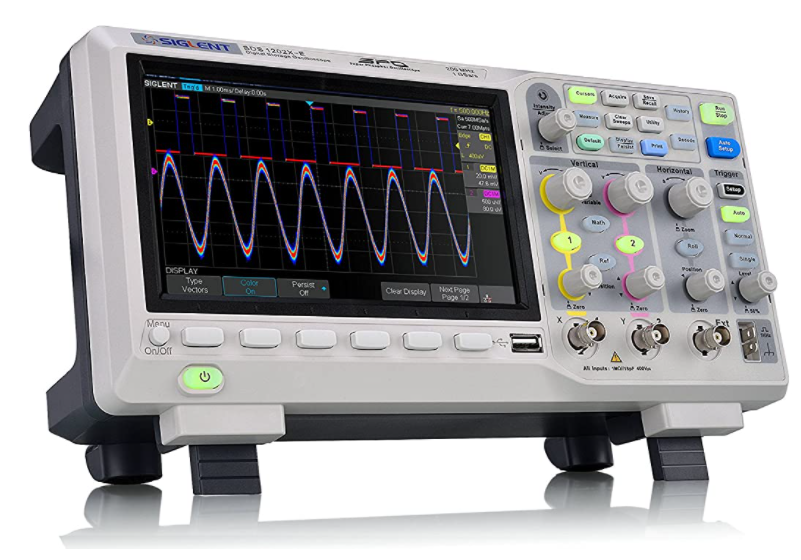
The Complete Buying Guide for Oscilloscopes
Oscilloscopes are used in a variety of fields, from physics to engineering, and used by a variety of people, from engineers to hobbyists. These instruments measure and display voltage over time and they are an extremely powerful tool to use when trying to troubleshoot an electrical system or acquiring results to test and verify your circuit design. It’s essential to have as part of your arsenal and the great thing is that they’ve become much cheaper, allowing just about anybody to get their hands on one.
But what should you look for when buying one? When considering the purchase of an oscilloscope, you should consider the frequency response, bandwidth, sampling rate, amplitude range, and number of channels. You will find these specifications on the oscilloscope’s datasheet.
As an example, we’ll be using the Siglent Technologies SDS1202X-E 200MHz Digital Oscilloscope, as shown below.

Siglent Technologies SDS1202X-E 200MHz Digital Oscilloscope
- 100 MHz – 200 MHz
- 2+EXT Channels
- 14 Mpts Record Length
- 1 GSa/s sample rate
Disclaimer
ProteShea, LLC is a participant in the Amazon Services LLC Associates Program, an affiliate advertising program designed to provide a means for sites to earn advertising fees by advertising and linking to Amazon.com
Some links may be affiliate links, in which ProteShea, LLC earns a commission if you use that affiliate link. Please note that this is at no additional cost to you and helps us in creating more content.
Bandwidth
The first thing to consider is the bandwidth of the oscilloscope which tells you what frequencies the scope can accurately measure. Most oscilloscopes have a bandwidth in the 50 – 200 MHz range, while the more expensive options have a bandwidth in the 1 – 10 GHz range. For example, if you have an oscilloscope with a bandwidth of 100 MHz, you’ll be able to measure signals with a maximum frequency of 100 MHz. Signals that have a higher frequency than the maximum bandwidth will be severely attenuated and will not give you accurate results.
Sample Rate
The sampling rate is how often a signal is sampled per second (Sa/s). Nyquist theorem states that a periodic signal must be sampled at 2x the highest frequency component to avoid aliasing (the phenomenon where high-frequency signals are misinterpreted as lower frequencies). So, if your signal’s maximum frequency component is 100 MHz, you must sample it at a minimum of 200 MHz. However, most oscilloscopes can sample a signal at 5x or even 10x it’s maximum bandwidth! If an oscilloscope has a bandwidth of 200 MHz, the sampling rate will typically be 1 GSa/s. Unfortunately, a higher sampling rate results in a higher cost.
Amplitude Range
The amplitude range refers to how large the signal voltage can be. You must be careful because if your voltage is higher than its maximum range, you could damage the analog-to-digital converter associated with the channel you’re measuring on. If your oscilloscope has a peak-to-peak amplitude range of ±25Vpp with a 1x attenuation, you must keep the signal voltage within that range. If it is higher, you can attenuate the signal by 10x by adjusting the setting on the probe and the corresponding oscilloscope channel. For example, if the signal you want to measure is ±250Vpp, set the attenuation to 10x which will attenuate your signal to ±25Vpp.
Number of Channels
Another thing to consider is the number of channels on the oscilloscope. This could range from 1 – 4 channels. Usually there is a trade between bandwidth and the channel count. For example, you might find a 2-channel oscilloscope with a bandwidth of 200 MHz, while a 4-channel oscilloscope will have a lower bandwidth of 100 MHz. It really depends on your application and what you have to measure. Having the ability to measure 4 different signals is nice to have since you have different stages of a circuit and most engineers or hobbyists don’t need to measure signals over 100 MHz.
Additional Considerations
Now that we’ve covered the main things to look for, there are a few more things to look at which are record length, portability, and connectivity.
The record length is how many data points it will capture over a certain time period. You can use a basic formula to calculate the time period, capture time = record length / sampling rate. For example, the Siglent has a record length of 14 Mpts and 1 GSa/s which equals 14ms.
As a student, portability was something I put more weight on. I wanted something that I could carry back and forth from lab and my home. I didn’t want to carry a heavy oscilloscope so I opted for a pocket-sized one which was able to get me through the labs. It has a USB interface which allows you to connect to your laptop and use the user interface to view the waveforms. It also had an integrated arbitrary waveform generator, logic and protocol analyzer, pattern generator, virtual digital I/O, and power supply! The bandwidth and sampling rate were lower at 30 MHz and 100MS/s, but I rarely needed to measure signals higher than that. If I did, I would just use one of the oscilloscopes in the lab.
Sometimes, you’ll want to be able to connect to your oscilloscope to capture waveforms, or in the case above, display waveforms on your laptop. You’ll see them come standard with a USB interface, but you can also get them with Ethernet or Wi-Fi!
About Author
Eric Shea is the founder of ProteShea and is an electrical engineer. He wishes to have a major impact on bridging the gap between engineering theory and real-world applications. He has worked at Kratos Defense, SpaceX, Air Force Research Laboratory, and Polaris Industries. He received a M.S. in electrical engineering from the University of Pittsburgh and a B.S. in electrical engineering from the University of Florida.
Categories
- Arduino (24)
- Artificial Intelligence (1)
- Guides (19)
- Home Automation (2)
- Off Grid Solar System (1)
- Raspberry Pi (2)
- Tips, Tricks, and Techniques (32)
- Uncategorized (2)
[…] The Complete Buying Guide for Oscilloscopes […]